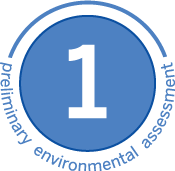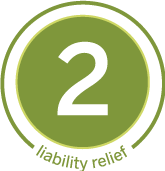Nearly every community has land parcels that were once bustling and productive, but are now empty, vacant or under-utilized. Wouldn’t it be nice to turn that property into something better? Perhaps a commercial building. Much-needed housing. Or a neighborhood park.
Now is the time to act. With $1.5 billion of federal funds available for brownfield redevelopment, municipalities and developers have more federal money than ever before to breathe new life into these properties.
Brownfields
Contaminated or potentially contaminated sites are called brownfields, and no two brownfields are alike. They can range in size and complexity, from a corner gas station to an abandoned factory along a riverfront. A building containing asbestos – which needs to be removed before the building is demolished or renovated – can also be a brownfield concern.
Brownfields can be eyesores. They may pose a danger to health and the environment. And they may lower surrounding property values.
Related Content: The Hidden Potential of Brownfields [eBook]

Redevelopment Opportunities
Yet opportunities abound. Brownfields often are located on prime real estate within communities, near city centers where infrastructure is already in place. Redeveloping brownfields can offer communities and developers a chance to bring properties back into productive use, which could help meet the market demand for more commercial, industrial or residential spaces – and create a revenue source by returning sites to the tax rolls. Brownfield properties could also be transformed into community assets, such as parks.

Many brownfield sites have been successfully transformed into community assets.
Site Cleanup Methods
Every site is different, so cleanup methods depend on the site and various factors that are unique to each project. A top goal of brownfield remediation is to make the site safe for people by doing what it takes to limit exposure to harmful materials. The project schedule is a key factor in determining the cleanup method. If the project is on a fast track, your option may be to excavate and refill with clean soil. But if there is time, project design changes could allow for as much in-place contamination management as possible while safely redeveloping the site. Know your cleanup options and choose one that works for your site and schedule.
Funding
Redeveloping contaminated sites often brings risk and uncertainty, but grants and loans are available to help turn ideas into reality. Each grant program has its own eligibility criteria and schedule, so it's essential to match a project’s outcomes with grant requirements. Sometimes a loan may be necessary for grant money to take effect. Tax increment financing (TIF), in which a developer doesn’t pay taxes on increased value for a certain period, may be another way to fund brownfield redevelopment.

Grant Money Is Available!
The big news is that the 2021 Infrastructure Investment Jobs Act designates $1.5 billion to brownfield redevelopment. This represents the largest-ever investment in brownfields by the federal government and builds on the U.S. Environmental Protection Agency’s (EPA’s) Brownfields Program. Funds will be awarded through grants and loans later this year.
We understand the challenges brownfield redevelopment sites pose for communities, developers and property owners. The unknowns of whether a site is contaminated and how much it might cost for cleanup creates uncertainty, making it hard to move forward or even know where to start. But accessing state and federal funding and knowing how these financial packages work together can help to begin cleanup and redevelopment.
Related Content: Onalaska Great River Landing Master Plan and Design

The Onalaska Great River Landing project in Onalaska, Wisconsin, realizes a long-held community goal to link the Mississippi River waterfront with business districts and a trail system, boosting economic development and recreational opportunities. The design team met with City staff and stakeholders and reviewed various ecological, hydraulic, cultural and historical documents before and during the design charrette to develop a better understanding of the site’s characteristics and potential for development.
Follow these four steps to put you and a potential developer in a better position to start redeveloping a brownfield site:

Determine the Good, Bad and (Potentially) Ugly
You’ll need to understand what it will take to redevelop the property. A preliminary environmental assessment will help reveal the depth and breadth of the problem. It’s also a critical first step in protecting your liability associated with potential contamination. You might learn that the site is not contaminated, and that may help ease of the mind of a developer. Or you may find that contamination is present at the site – and you can seek funds to help cover the cost of cleanup. In either case, the path forward starts with having enough information to guide decision-making.

Know the Law and Liability
If the site is contaminated, there are options. Laws exist at the federal and state level to minimize potential risks to municipalities and developers and help determine if another entity might share the cleanup responsibility. At the federal level, the Comprehensive Environmental Response, Compensation and Liability Act (CERCLA) and the Brownfields Community Reinvestment Act set the stage for brownfields redevelopment. At the state level, voluntary brownfields programs further encourage public- and private- sector involvement in remediation.

Brainstorm Potential Site Uses Based on Community Needs
Collaborate with planners and economic development officials and use market research to understand the options you have. The site may have been the home of a manufacturing plant, but remediation could open the doors to new types of uses, such as businesses, industries, residential buildings and green spaces. Existing community plans (such as comprehensive plans or land use plans) and community engagement are good starting points. You can incorporate what you learn through community engagement and market research into reuse concepts to share with potential developers.

Match Site Challenges to Specific Funding Programs
Each brownfield site is unique, and various financial and incentive programs exist that may help solve specific challenges. Grants and loans can be a critical funding source for cleanup. Tax credits may be a worthwhile incentive. Your clean-up costs could be fully tax-deductible. Or you can use funds from one program to leverage funds from another program – use them as matching funds.
Very Rewarding Work!
Communities can benefit from brownfield redevelopment, because brownfield sites often provide an opportunity to achieve goals that are part of community plans. By turning an empty site into a home for a new, thriving business or residential property, you’ll have a healthier, more vibrant community. Brownfield redevelopment can add value to local real estate, create jobs and expand your community’s tax base. The EPA estimates that through fiscal year 2020, each $1 of brownfield funding leveraged over $20 in private investment in brownfield sites, and for every $100,000 of brownfields funding, 10+ jobs were created.
Blighted, under-utilized and vacant property can be redeveloped by understanding the site challenges, matching the site’s environmental needs to funding programs, and looking for innovative ways to finance and attract a broader range of interested developers.
While brownfield redevelopment can be challenging, these challenges can be overcome when you collaborate with stakeholders and access state and federal programs. When a brownfield site is cleaned up, the community benefits. This makes the work very rewarding.
Jennifer Force
About SEH’s Brownfield Redevelopment Team
SEH understands the challenges that brownfield redevelopment sites pose for communities, developers and property owners. Our team of planners, funding experts, scientists and engineers are adept at understanding complex redevelopment needs from concept to completion. SEH has successfully completed many brownfield remediation and redevelopment projects. We've worked with community stakeholders to navigate the complex processes associated with environmental due diligence, reuse planning and cleanup, as well as successfully finding and leveraging brownfield grant dollars.
About the Authors

Jennifer Force is a senior project scientist with a diverse background in site assessment and cleanup. She has assisted clients with due diligence by conducting Phase I Environmental Site Assessments (ESAs), Phase II ESAs and soil vapor investigations, developing cleanup plans implemented concurrently with redevelopment, and securing liability assurances and regulatory approvals. Jennifer has prepared numerous grant applications and secured over $22 million in investigation and cleanup grants from local, state and federal programs.


